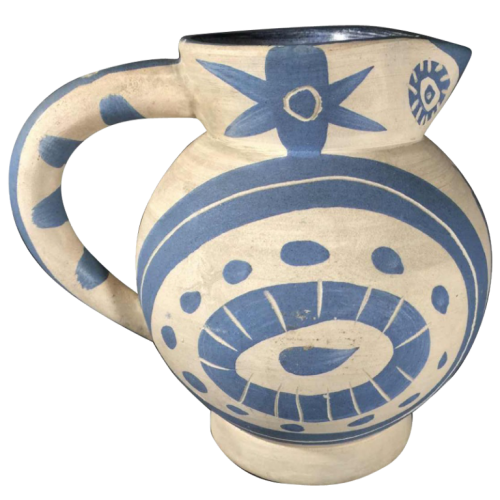- Creator / Artiste / Designer:Pablo PICASSO (1881 - 1973)
- Signature / Monogram:Signed ' Madoura Plein Feu ' ' d'après Picasso '
- Editor / Manufacture:Madoura
- Marks / Stamps:yes
- Period:20th century / circa 1960
- Country of origin:France
- Dimensions (H x W x L):12,9 x 11,9 cm
- Wheight:0,5Kg
- Condition:Excellent
- Styles:Cubism / Expressionnism / Surrealism
- Materials:Céramique / Faience
-
Price:SOLD
'Petite Chouette' - 'Little Owl', white earthenware pitcher partially painted in blue with incised details.
Executed in a limited edition (200 copies)
Stamped 'Madoura Plein Feu' 'D'après Picasso'
h. 12.9 cm d. 11.9 cm
At the end of the 1940s, Pablo Picasso (Spanish, 1881-1973) began to create ceramics. During his travels on the Côte d'Azur, he was inspired by the clarity of light and the bright colors of the Mediterranean.
The artist visited Vallauris for the annual pottery exhibition in 1946. Impressed by the quality of Madoura's works, he was presented to the owners, Suzanne and Georges Ramié, who welcomed him into their studio and gave him access to all the tools and resources he needed to express his creativity with ceramics. In exchange, the Ramié family would produce and sell their ceramic work. This collaboration with local ceramists lasted 25 years.
Picasso continued to create pieces of clay during the last years of his life. He first discovered that working with clay was a relaxing summer respite from the more demanding demands of painting.
He started with simple functional objects, such as plates and bowls, and then proceeded to create more ambitious shapes, such as jugs and vases, where the handles became facial or anatomical parts of the animal. represented.
The subjects are very creative and playful and include, among others, Greek mythological figures, forms of animals, such as owls and fish, scenes of bullfighting and face patterns.
